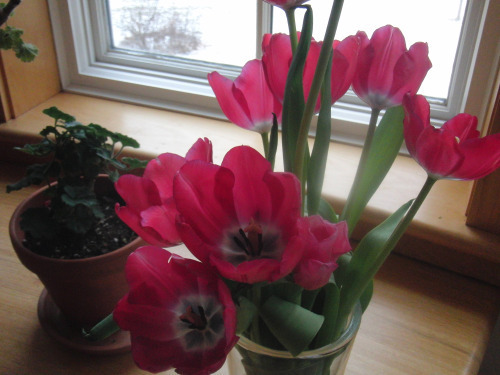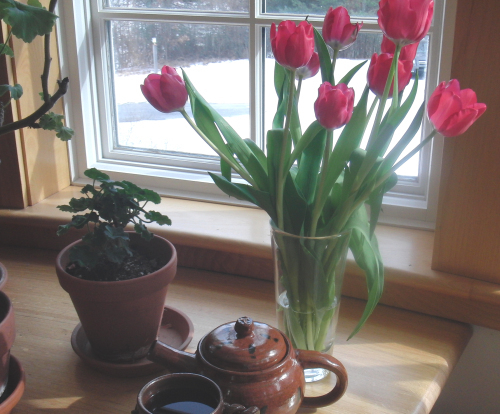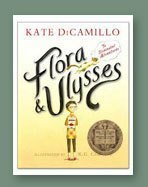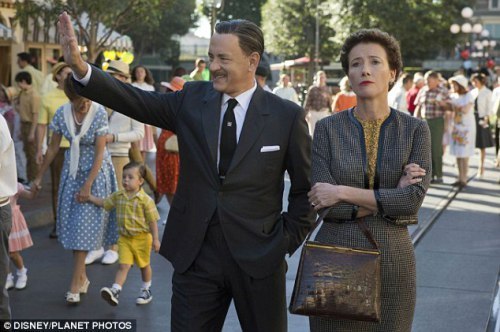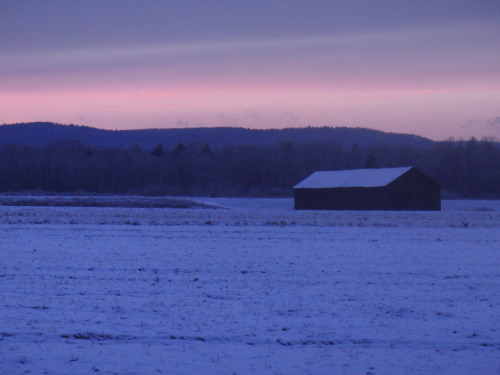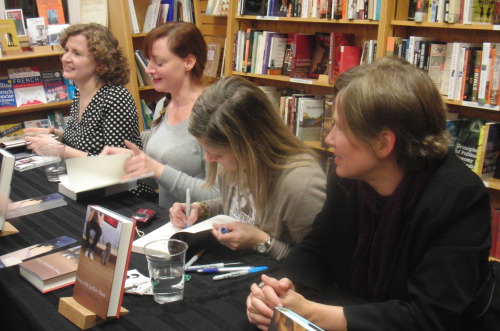Jeannine Atkins's Blog, page 17
February 3, 2014
Who’s the Judge?
Every red petal on the tulips remain, along with much of the snow in the yard, as I settle on the window seat for another day of writing. Last week I gave the first third of a verse novel about three different girls to my writing group. The second section is well underway, as I drafted the whole book before polishing a section enough to bring it to my friends, which I did without a sense of it being entirely done or quite close to wonderful. The section I’m working on now delights me with its smooth progress. I feel I know and love this girl. But I wonder if the poems are any better and accessible, a word I return to as a guide, along with the image: clear as water. I want flight, but the kind that young readers can follow. I feel I might be flying too high to follow in that first section. This middle section has the right weight, and is more like the lake I’m attempting. Maybe.
We can’t and shouldn’t get away from judgments: Does this line work? Will it make someone laugh or think? Is it even clear? But much should judgment be part of our actual writing? Learning when to let it into the process may take at least as much time as learning particulars about style and structure. We’re unwise to expect perfection-ish-ness from something that isn’t finished. For me, writing means accepting whatever comes my way first, evaluating later. Others write and assess one sentence or paragraph at a time. I have a high tolerance for mess, with high hopes for what it can turn into, and am happier writing a meandering draft that I’ll trim, polish, and send to my writing group for their gently but firmly told truths.
Can we circle from judgment back around to acceptance that we’re moving along the best we can, making a way between effort and complacency? Can we stretch and bend in every sentence? It’s yoga. Reach and concede or adjust. At last the thoughts of our first friendly readers and ourselves may bring us to a place where we believe our work is good enough for the eyes of people we may not know called editors. This sounds like it should be a step as simple as jumping over a fence, which maybe it is, but the fence is high and wide. We’re going to meet new judgments, which may revolve around how well the work succeeds at what it attempts, or instead raise issues beyond our words, such as the size of the potential audience, or slippery issues of taste.
Decades ago, I was lucky to learn that editorial judgments are a dangerous place to measure self-worth. In my work-study job at UMass, I wrote “Sorry” on small rejection notes for a literary magazine. That single hand-written word couldn’t show what happened in the basement office where intelligent people sometimes argued about a poem for twenty minutes. Someone laughed through one story. Wept at the end of another. Clattered coffee cups while piling them to wash in the bathroom and muttered, angry that a story didn’t make the cut. I learned that an editor’s response to a manuscript isn’t Fate’s or a reliable way for an author to decide whether or not a piece of writing is good. There was always more to the story than a rare “Yes” or the far more common, “Sorry.”
We’ve been trained through most of our lives to expect others to let us know when we’ve got something right, but that’s risky with creative work. Editors can be a lot of things, but they won’t necessarily be our final judge. We’ve got to learn to make our own assessments. Which seems to take a lifetime. But if I keep writing until the tulip petals fall, a few words will find their right places. That’s what I’m trying to trust.


January 31, 2014
Slow-Slipping Words
I’ve got a pot of tea made from rosehips, dried apples, and blueberries that my sister sent me for Christmas. And red tulips, with equally stunning green stems, my husband brought from the supermarket. These don’t bring the pleasures of speed, whatever they might be, but remind me that all I have to do is move my fingers slowly across the keyboard now and then. Writing is not racing. It’s a slow sport, with breathing closer to dozing than dashing. It’s a tightrope, moving on, while looking back, checking out the word-footprints.
I’ve started a semester of teaching, and on Tuesdays and Thursdays I choose clothes from my closet instead of the handy ones in the drawers. It’s good to see beautiful young people wearing orange sneakers and whimsical hats and to hear thoughts about books. My classroom is not fast-paced, but I feel a certain pressure to get across ideas that will be useful to twenty-three people with different goals and needs. At one point yesterday I said, “Let’s go back and just take a look at the first page. What pulls you in? What suggests the setting and where we might be going?”
There were a few beats of silence before a young man raised his hand and said, “The first word of the book is ‘where.’ That’s kind of mysterious.”
I’d been thinking about sentences and images, but I looked at that first word with newfound admiration. Yes, a brilliant way to start. We admired some other language and imagery before someone settled on the drawn-out beauty of the word “seemed,” the way it stretched out a sentence and linked two possible words.
We got back to a hastier style of running sentences together, making judgments. And a professor has to look at the clock. But now back in my writing room I’m remembering to soak up the possibilities of words like “where” or “seemed,” to revel in vowels and single syllables and all the places they might take me. I stop to look back and fret about what’s ahead, but come around again to focus on the words just beneath my fingers. Maybe a petal will fall. The tea cools. That’s the pace I’m keeping.


January 29, 2014
The Beginnings of Two Books: FLORA AND ULYSSES and CHARLOTTE’S WEB
When I began writing for children, I was pretty vague about the possible prizes. I knew some books had shiny stickers, but not that every January carefully-chosen groups of librarians gathered in secret to choose the year’s most distinguished novel for children. More recently, I learn on facebook the day when the Newbery and other ALA awards will be chosen, and go back there as friends report the prizes as they’re announced. Hearing that Kate DiCamillo won the Newbery for FLORA AND ULYSSES, I headed to my local library just after it opened. I remembered seeing the book on display, and could snatch it before requests started flowing in.
I also read an interview and learned about how Kate started the novel after seeing a dead squirrel on the sidewalk and, frequently, a vacuum cleaner that had ended up in her garage, still ridden with cat hair, to which she’s allergic, after her mother died. I see these on the first pages, though the squirrel remains alive, and soon will be writing poetry, after a hazardous encounter with a rambunctious vacuum cleaner. Kate DiCamillo also mentioned that she was inspired by reading E.B. White’s essay, “The Death of a Pig,” which led to the novel that won a Newbury Honor in 1952.
I’ll get back to her novel, but turned to CHARLOTTE’S WEB, which my UMass class was just about to adore and gently pick apart, as is our English Department duty. A student remarked on how Charlotte was a writer not only as she drew silk to form the letters in her web, but through her whole way of being: taking time to muse and reflect, moving between single words, each weighed, and her larger goal. She sometimes seemed to others not to be doing much as she sat high in the beams of the barn, where she had such a good view, but she was. It’s just the third day of class, but I already adore my students.
Critics have mentioned how E.B. White’s three books for children all circle around a character with something that makes him not quite fit in: Wilbur is a runt who’s almost killed for that, Stuart Little is a two-inch-tall boy who looks like a mouse, and Louis is a trumpeter swan who can’t speak. They’re all boys, but from what we know about E.B. White, he was more like Charlotte and Fern Arable when she sat on a stool in the barn and listened to the animals then he was like anyone else in the book. As a shy boy, he was at happiest sitting silently among soft-breathing horses in a stable, and while he worked in New York City as a young man, he was glad to buy a farm in Maine and settle there. He didn’t like crowds and kept a distance from awards, which he spoofs in this novel. At his funeral, his stepson said, “If Andy could have been here, he wouldn’t have been here.”
E.B. White took his time, saying that he started STUART LITTLE for his six year old niece, finishing it up when she was in college and reading Hemingway. The quiet places where he found inspiration, and a kind of holiness. He said, “When you enter a barn cellar, raise your hat.” And he gave us that barn where a true friendship is made and a writer does her life’s work.
Kate DiCamillo said that after getting the early morning phone call with librarians on speaker phones telling her that the novel she wrote had won the Newbery Award, she didn’t know what else to do, so she sat down and wrote. I think E.B. White would like that.


January 24, 2014
Charm Strings
When poet Amy Ludwig Van Derwater announced she was putting together a string of buttons Victorian ladies called a charm string, and requested a button from friends, I spilled out my button box. Memories rose from the soft clatter. One green cloth button was from a vintage coat I bought during the first winter my husband and I spent together. A wee frog was from when my grown daughter was a baby. Bent and broken paper cards of buttons had been retrieved from my mother’s jar of buttons after she died. And I found a few wooden buttons I’d bought after the owner of a used bookshop gave me a copy of Maine Charm Strings, decades ago, saying she thought the book was meant for me.
Recently I spoke with a friend about journals we had as girls, and how often first diaries are gifts from older women: that precious belief that we had something to say, before we knew that ourselves. I also love the idea of buttons moving from hand to hand, with their various colors, shapes, and the vaguest hints of stories, which change in every pair of ears, eyes, and hands. You can read more about Amy’s quest for buttons and words at The Poem Farm. And please comment there before next Thursday for a chance to win a copy of my book, Views from a Window Seat.
The gift of one book inspired one of my own, set in nineteenth century Salem. It was never published, but below is an excerpt in which Lucy’s older sister introduces her to charm strings:
“You’re just the right age to start a charm string.” Caroline lowered her voice the way she did whenever she spoke of magic. She unrolled some string saved from packages. Using tiny bird-shaped scissors, she snipped off a piece of string as long as Lucy’s arm.
“All you have to do is thread the buttons together. Every button should be different. Start with a large one. That round wooden one looks good. You put them on the string until you have nine hundred and ninety-nine.”
“What happens then?”
“Your life changes. You win the great dream of your heart.”
Lucy laced the string through two holes in the polished wooden button, then threaded on a brass, china, and cloth-covered button. She looked through the buttons darkened by time and chose one that was fan-shaped, one with a picture of a solemn, still robin, a speckled stone button and one made from a ribbon coiled into a rose. The rest were plain and round, but smooth as the wave-worn rocks on the beach. They felt good on her palm.
Caroline picked up another one that showed a cat with tiny painted whiskers, a little dot of a mouth, dark ears, and a curled-in tail. “Don’t take so many that the pile looks smaller when you’re done. Twelve buttons is good to start. After this you either have to find the buttons or they should be gifts. The more buttons you get, the luckier you’ll be.”
Lucy slipped a silver button on the string. The sound was soothing, like milk splashing from a pitcher. “If you don’t have all the buttons you need, how do you know that it works? Mother says you shouldn’t believe everything you’re told.”
“Sometimes you have to be content with hints instead of proof. You don’t expect the seashells and stones you find washed up on the shore to tell you everything about the ocean. You can’t expect clouds to spell out the afternoon’s weather.”
“That’s different.”
“Mother’s right that you shouldn’t believe everything you hear, but if lore has been passed along, it’s lasted for a reason.”
For more Poetry Friday posts, please visit Tara at A Teaching Life.


December 23, 2013
Saving Mr. Banks: Stretching, Shrinking, or Sugar-coating Truth
I had quite a jolly time watching SAVING MR. BANKS, though a little way in when my daughter leaned toward me to ask, “Is she still alive?” my whispered “No,” held a big breath of gratitude, certain P.L. Travers would have liked none of this. There’s rarely a happy meeting ground between lovers of the series of MARY POPPINS books first published in 1934 and the 1964 Disney movie starring Julie Andrews and Dick Van Dyke, and this movie may only escalate the tension.
As a writer, I’d like to whole-heartedly take the side of P.L. Travers, who was born named Helen Goff, and her books, charmingly illustrated by Mary Shepard. But then there’s the heart-tugging “Feed the Birds” and “Let’s Go Fly a Kite” written by the Sherman brothers, the singing of Julie Andrews, the dancing of Dick Van Dyke, and what can I say? I’m smitten. Disney did play freely with the first novel, which was written in chapters with beginnings and ends, good for bedtime, like other British classics of the period, including WINNIE-THE-POOH , PETER PAN, and THE WIND IN THE WILLOWS. Disney needed to shape the episodes into an arc, and in conjunction with not wanting to perplex Americans in the early 1960s with the concept of nannies, created a reason for Mary Poppins to come and go, though no reason is given in the book, and is part of its point that life is random. A movie needs to rise and fall, and while I’m uneasy favoring a film over a book, my feelings on this one are like that of WIZARD OF OZ, in which the MGM creators pulled forward the theme of “There’s no place like home” and edited out some of the book’s wayward adventures.
Still, watching SAVING MR. BANKS I was somewhat troubled to see P.L. Travers depicted as a rather nit-picky diva, needing a bit of saving by Walt Disney, who’s shown not just as a creative businessperson but steps in as psychoanalyst. “Saving Mr. Banks, but Throwing P.L. Travers Under the Bus” by Jerry Griswold made me nod in many places. It’s good to hear that the author was nice, deep-thinking and well-liked, more so than the woman played by Emma Thomas in the movie, who’s rude and she sniffs, which may not have been primary traits of P.L. Travers, but do distinguish Mary Poppins as we know her in the book. I told Emily I expected P.L. Travers was surely kinder. But as I read about her last night, hoping for confirmation, I could see that Disney might have given P.L. Travers some breaks. When I reported some faults to Emily, she said, “Sorry, Mom.” There were those tapes that P.L. Travers insisted upon being made at the Disney studios, and prickly remarks were recorded. Good and bad manners may depend upon context, and it seems that while sentimental and greedy Americans may have gotten the bulk of her ire, they weren’t alone. Jerry Griswold found her delightful, but then he is an admiring children’s literature professor who crossed the ocean to interview her for THE PARIS REVIEW. I would have liked to see P.L. Travers shown as slightly more complex, but in SAVING MR. BANKS, she may have been given a fair hand.
Her life was shaped to create a story arc that includes flashbacks to her childhood in the Australia outback, and is based on facts such as her father, whose first name was Travers, had been an alcoholic who had trouble keeping jobs in banks. While Walt Disney gets the insightful lines, he’s masterfully played by Tom Hanks, who shows flashes of tamed temper and the plaster behind some smiles. His secretaries seem to have a heaviness in their smiles and shoulders, too, and their varying stiffness and haste show they deal with a man who respects childhood, but is not all about merry-go-round rides. I loved the roles of the scriptwriter and the Sherman brothers as lyricist and composer, beautifully played by B.J. Novak (Ryan in The Office) and Jason Schwartz. I read that they spoke at some length with Richard Sherman as well as people who knew both brothers to understand the differences between them as well as what made them a great creative team. Caitlin Flanagan’s interesting New Yorker article, ”Becoming Mary Poppins,” quotes Richard Sherman and makes it clear how much the brothers’ work shaped the narrative arc of the musical.
A movie is not a book and it’s certainly not a life. Is SAVING MR. BANKS a trusty reflection of a British author in Hollywood? A lot is left out, of course. Some things are stretched, some shrunken, and there’s sugar where it might not be expected. Maybe it’s best not to compare the movie to a life, but to just enjoy and be touched, as I was. What it shows is that art and life are complex. Childhood, in all its sweetness and darkness, stays with us. Creative people find creative ways to move on, while circling back to days when we learned about love.


December 18, 2013
Blinking at the Bright Lights
Sometimes writing is hard and sometimes life is hard. Almost always there’s an overlap, no matter whether we’re writing about fantasy worlds or life a hundred years ago. The work may be hard because of the subject, or because we’ve been at it so long without dreamy results, or because we’re feeling pulled in too many directions, or, well, most of us can cite our own reasons, which may include it being that lights-in-the-darkness time of year when it’s tough to remember we can’t have one without the other. Or we get tired of all that twinkling. We can’t look back, which can bring comfort, without some feeling of loss. We can’t always tell the difference between feeling full and feeling empty. I like a season that calls for sparkle, sprinkles, evergreen, and candles, and this year I particularly look forward to a day when I’ll be with my husband, daughter, and other friends and family including a four-year-old who might bring whole-hearted glee to a lit-up tree and a bounty of small trains and trucks. But I get that everybody doesn’t like Christmas, and it’s not like even those of us who hum songs about stars are happy all the time. Or won’t spend part of the day tucked away doing some writing or reading Donna Tartt’s THE GOLDFINCH.
We can’t write books without spending time with whatever is in our head. Every book I’ve ever written has taken longer than I’d thought, and while I try to be patient, sometimes I’m just annoyed. Many drafts don’t reach my standards, and it’s tough to sound breezy when I tell myself to try again. Drawing connections between our minds and words is tricky and awesome and it can make our typing fingers ache. It’s natural to want to dash away from eyes or throats that feel tight. Get a snack. Gosh, even get some exercise. Anything. This is when I train myself to stick it out, because something of note is often behind my glazing eyes. Just as we’d tell a good friend to talk even when it’s a story neither of us really want to hear, we should offer our own selves the proverbial shoulder to cry on. Be kind, but remember that kindness doesn’t mean flight. Get a quilt if you want and a cat if you can. Turn on or off the light. Find a candle or a different chair. But I think it’s good to let our throats tighten until they soften, which they will. If we’re lucky, the sun may slant through the window.
Writing can be particularly tough if we’re telling a sad story, or are in a melancholy mood. Sometimes we need to step away, but there are also good reasons to blow our noses and keep our eyes on the screen. It’s not exactly barreling through, but the tears may mean we’re onto something we shouldn’t turn from. A place that not only pulls our attention but will ask readers to step in and hang on, too. Writing isn’t a profession for the timid. In Eudora Welty’s lovely and a little-bit-fierce memoir, ONE WRITER’S BEGINNINGS, she writes. “A sheltered life can be a daring life as well. For all serious daring starts from within.” Serious daring. Tears can be a sign of that, rather than a sign of vulnerability to be shut down or reserved for later.
Thinking, feeling, and writing can be hard: that’s pretty much all I know, which doesn’t sound too helpful except that I believe that at some point there is a way out. And sometimes, of course, let’s be real, we do need to take a walk, find some chocolate, cover our heads with a blanket, call a friend, or go on to something else. All we can do is make our best attempt to stick with our visions, remembering that telling our mind to stop anything can be telling it to stop everything. Words may come from a prickly place, but as we smooth out the language, we may feel smoother inside, too. The stories that hurt may be the stories that matter. The stories that break our hearts may open the hearts of others.


December 16, 2013
What I’m Reading: The Signature of All Things
As soon as I learned that a nineteenth century woman naturalist was the main character of Elizabeth Gilbert’s THE SIGNATURE OF ALL THINGS, then opened to reproductions of antique floral paintings on the endpapers, I knew I wanted to read it, but I didn’t expect the humor that flashes through much of Elizabeth Gilbert’s fascinating novel. You’d hope I knew better, but I fell for the stereotype of over-serious scientist. I was surprised and smiling on the first pages, when an array of people respond to the main character’s birth with an array of blessings and disappointments that have little to do with the fact of a baby. Then we skip to a description of the grandfather, “an orchard man at Kew –a humble man, respected by his masters, as much as anyone can respect a humble orchard man.” There’s a sense of the ghost of Charles Dickens hovering, with an eye that sees through pretentions, with a tone that’s always warm-hearted.
The novel proceeds in a Victorian way, spending a good amount of time away from our heroine to learn about her genealogy. Fortunately, her father is a rogue who sails with Captain Cook, having adventures on sea and islands that will appear later, for a nice structural balance. And then there is Alma, who is shown never larger than life, but we are always aware of her sometimes awkward body, her excellent mind, her deep loves. We get well-drawn pictures of the world she loves: at dinner tables with good silver and china, in her library hideaway, in a cave made of mosses, aboard a ship, and in gardens. Her life seems believable in the decades of routines she follows, and the occasional wild surprises. She’s sort of odd and sort of ordinary, wonderful and baffling, so that I could keep reading even when the plot turned in what to me seemed a wrong way. I was glad I stuck it out. The ending couldn’t have been more perfect.
The themes of various passions are woven well throughout. I particularly liked a scene in which Alma apologizes because her writing about mosses has been read and admired, but only, she says, by about twelve experts in the field, and the man we see her falling in love with exclaims about what a marvelous number twelve is. Now we fall for him, too, and with Elizabeth Gilbert, who after selling millions of copies of EAT, PRAY, LOVE, knows a thing or two about what matters and what doesn’t. I wasn’t a big fan of that book, though I enjoyed the eating part. I love that the person who wrote that book could write this different and truly wonderful novel, and admire how she made such a transition. Some of how she managed to keep writing about whatever she feels most matters at the moment is suggested in her lovely essay about poet Jack Gilbert and the courage, wonder, and self forgiveness necessary for a writer, or anyone.


December 14, 2013
Young Adult Author Panel at the Odyssey Bookshop
Last night I had a great time at the Odyssey Bookshop in South Hadley, MA, where four writers were introduced with lively introductions and listeners were treated to a raffle for books and bags. Each author spoke and read short passages from her most recent novel, then answered questions from the audience. After being asked where they get their ideas, Deborah Noyes, whose most recent novel, THE PLAGUE IN THE MIRROR, involves time travel between 14th century Italy and the city of Florence today, said that she was inspired by finding connections between places. Jo Knowles said that she usually begins with some question that tugs at her, but in the case of her fifth novel, LIVING WITH JACKIE CHAN, which takes up the story of a character from JUMPING OFF SWINGS, she was answering readers’ questions about a teen father who wouldn’t quite let them go. N. Griffin, author of THE WHOLE STUPID WAY WE ARE, said that most of her ideas come from daydreams and other forms of procrastination, which can have their own richness. Julie Berry said that beginning her writing career as a humor columnist she kept alert for anything with the potential to be funny. Now that she’s writing novels, most recently ALL THE TRUTH THAT’S IN ME, with its themes of abuse and silence during the colonial period, she says she keeps a sort of radar for anything that has the potential to be a story, and keeps a notebook with these ideas.
Another question was about how to take characters you have to deeper places. Julie Berry said that while characters may have one main reason for being there, such as to be funny or rebellious, she considers their entire life stories, including their family roles, what’s embarrassing to them, or what they eat when nobody’s looking, in order to see them from a new angle. N. Griffin spoke of trying to imagine herself within her character’s bodies; once she has a feel for how they walk, slouch, or stretch, she explores why they carry their bodies the way they do. Jo Knowles alluded to Kate Messner’s advice to strategize by writing: “This books is about…” and then underneath, “But what the book is really about is…” as a way to explore the layers of plots and develop these to themes. There were more wonderful answers to wonderful questions, but I left thinking about this one. I’m going to try these strategies along with my own of asking of each character, How are they very unique? And how are they like every reader? Looking for unique and common ground.


December 13, 2013
Poetry and Houses
Writing a verse novel based in history begins with an idea of a time, place, and person I want to inhabit for some time. I research, taking breaks to mull, write ideas for scenes, jot down images to linger with and toss about. Sometimes I find a phrase or line I expect will stay instead of fade into the necessary background. I’ve moved on from most research on my current project, composed some rough poems, patted down lines, and gotten down on my knees to arrange and rearrange them into something I call plot, trying not to choke on the word with its history of personal failure. I prefer to think of this work as Colored Pencil Days. I made a list of questions my main character is asking, and where she gets stymied, and where at last she charges through. I’m happy enough with my order, which will shift.
After laying all these bricks, I’m looking forward to batting some out, cracking the cement. Of course even during this brick laying stage, I’ve had my reverie-ish moments, or why not write straight nonfiction? Now when I have my base, I want to kick a few cracks in the foundation and see how much fancy I can get away with, while still keeping readers who will care about science and history. There will be rubble and bruised toes and maybe a logjam. But I’m going to try to this with bare feet, because it’s time to feel the cold, the grit, and maybe something soft as grass. I want to make sure that every word is alive and awake, which means it can be changed. The walls breaking down, the layers peeling, has an instructive movement all its own. Nothing must be held too tightly.
Figuring out the plot is to take the long view, while this kind of revising calls for the kind of tenderness we feel when something is close enough to touch. I’ll toss each poem into the air and see what scatters, and what I can gently wrangle into new holes. Then it will be time again to stand up straight, put my boots back on, look up, and make sure I have a house.
For more Poetry Friday posts, please visit Tabatha Yeatts: The Opposite of Indifference.


December 10, 2013
Building and Wrecking Walls of Words
Lately and pretty much always, I’ve been putting in words and taking them out of my manuscript. I used to have a fantasy that one day I’d get the hang of this, and put in the right words the first time. Now I take the rhythm of type-delete-type for granted. Starting out writing badly is kind of the point. There’s a lot of scatter before sentences. Words like to free flow before lining up, and we have to stir up stuff we get to explore. No matter how experienced a potter is, she always has to get her hands dirty.
Good writing means dealing with both the known and the unknown. We become adept at balancing routines, rituals, and breaking away, just as we do with holiday fanfare or hush. While making favorite dishes, it’s hard to resist a few experiments. When the food doesn’t come out the way it looked in the magazine picture, or just isn’t particularly tasty, rather than stage hopefully-small fits in the kitchen, we shrug or laugh, take our particular form of forgiveness, and move on. There’s always the turkey and mashed potatoes. We step forward, we make mistakes, we try again.
Why should writing be different? We attempt a poem, and when it doesn’t meet the pretty picture we envisioned, well, we give it some more time or come in from a new angle. Even if the theme of the work is serious, I try to take breaks from a somber tone, to keep from taking my own self too seriously, to let my shoulders insist this is Labor. If I’m alone in the house, or I should say just with understanding pets, I sometimes stand up and do a jumping jack or two. Whistle or whoop. Then get back to it, in a different state of mind.
Step by step, I edge toward revision, which is not the time to bring in the brooms, but to stir up a bigger mess. Revision means going back to dredge through what we first came up with. Kicking holes while asking new questions, which lead to still more questions, which stage greater messes, demanding we again haul out the trash and finally tidy. Or is it truly done? Can anyone really tell?



